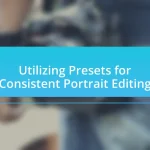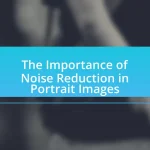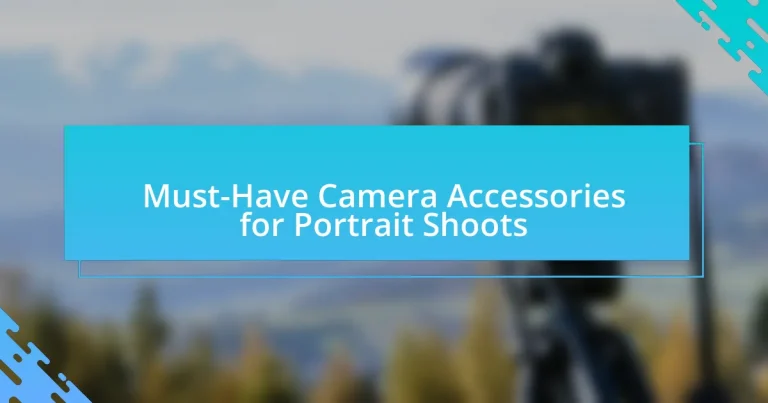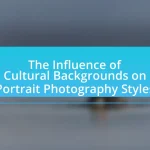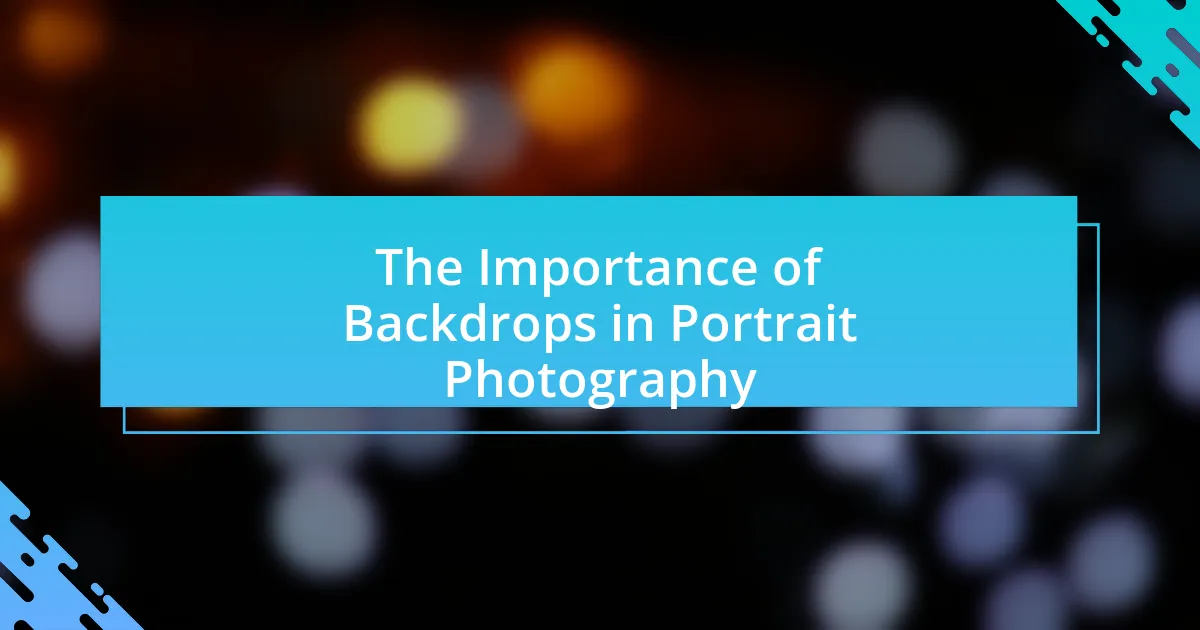The article focuses on essential camera accessories for portrait photography, highlighting items such as tripods, external flashes, reflectors, and lenses with wide apertures. These accessories are crucial for enhancing image quality, controlling lighting, and improving composition. The discussion includes the importance of lighting accessories like softboxes and umbrella lights, as well as the role of backdrops and props in shaping the mood of portraits. Additionally, the article emphasizes best practices for using these accessories effectively to achieve professional results in portrait photography.
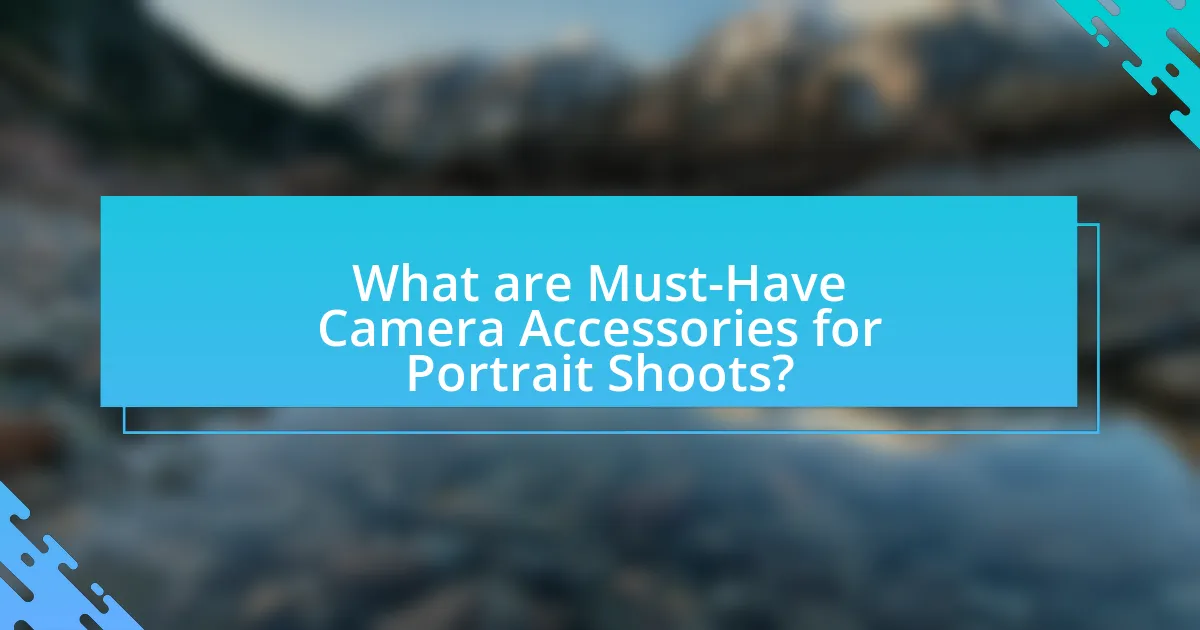
What are Must-Have Camera Accessories for Portrait Shoots?
Must-have camera accessories for portrait shoots include a tripod, external flash, reflectors, and a lens with a wide aperture. A tripod stabilizes the camera for sharp images, especially in low light. An external flash provides additional lighting, enhancing the subject’s features. Reflectors help bounce light onto the subject, reducing shadows and creating a more flattering look. A lens with a wide aperture, such as f/1.8 or f/2.8, allows for a shallow depth of field, isolating the subject from the background and creating a pleasing bokeh effect. These accessories are essential for achieving high-quality portrait photography.
Why are camera accessories important for portrait photography?
Camera accessories are important for portrait photography because they enhance image quality and control over lighting and composition. Accessories such as tripods stabilize the camera, reducing motion blur, while reflectors and diffusers manipulate light to create flattering skin tones and reduce harsh shadows. Additionally, lenses with wide apertures allow for shallow depth of field, isolating subjects from backgrounds. Research indicates that proper lighting and stabilization can improve the perceived quality of portraits, making accessories essential for achieving professional results.
How do accessories enhance the quality of portrait shots?
Accessories enhance the quality of portrait shots by providing improved lighting, better focus, and creative elements that elevate the overall composition. For instance, using reflectors can manipulate natural light, softening shadows and highlighting facial features, which is crucial for achieving a flattering look. Additionally, lenses with wider apertures allow for a shallow depth of field, isolating the subject from the background and creating a professional aesthetic. Furthermore, accessories like backdrops and props can add context and interest, making the portrait more engaging. Studies show that well-composed portraits with thoughtful accessories can significantly increase viewer engagement and emotional response, underscoring their importance in photography.
What role do accessories play in the creative process of portrait photography?
Accessories play a crucial role in the creative process of portrait photography by enhancing the visual storytelling and overall aesthetic of the images. They provide photographers with tools to manipulate lighting, add texture, and create a specific mood or theme, which can significantly impact the viewer’s perception of the subject. For instance, using reflectors can help control shadows and highlights, while props can add context and depth to the portrait. Studies have shown that well-chosen accessories can elevate the emotional resonance of a photograph, making it more engaging and memorable for the audience.
What types of camera accessories are essential for portrait shoots?
Essential camera accessories for portrait shoots include a tripod, external flash, reflectors, and a lens with a wide aperture. A tripod stabilizes the camera for sharp images, especially in low light conditions. An external flash provides additional lighting, crucial for achieving well-exposed portraits. Reflectors help bounce light onto the subject, softening shadows and enhancing features. A lens with a wide aperture, such as f/1.8 or f/2.8, allows for a shallow depth of field, creating a pleasing background blur that emphasizes the subject. These accessories collectively enhance the quality and creativity of portrait photography.
What are the key lighting accessories for portrait photography?
The key lighting accessories for portrait photography include softboxes, reflectors, and external flash units. Softboxes diffuse light, creating a soft and even illumination that flatters skin tones and reduces harsh shadows. Reflectors bounce light onto the subject, enhancing highlights and filling in shadows, which is essential for achieving a balanced exposure. External flash units provide additional light sources, allowing photographers to control lighting conditions in various environments. These accessories are crucial for achieving professional-quality portraits, as they enable photographers to manipulate light effectively to enhance the subject’s features.
How do lens filters contribute to portrait photography?
Lens filters enhance portrait photography by controlling light and improving image quality. They can reduce glare, enhance colors, and soften skin tones, which are crucial for flattering portraits. For instance, polarizing filters minimize reflections and increase color saturation, making skin tones appear more vibrant. Additionally, diffusion filters can create a soft-focus effect, reducing the appearance of blemishes and imperfections, thus contributing to a more aesthetically pleasing portrait. These effects are supported by the fact that many professional photographers utilize filters to achieve specific artistic outcomes in their work.
What types of tripods are best suited for portrait shoots?
The best types of tripods for portrait shoots are sturdy, adjustable tripods with a ball head or pan-tilt head. These tripods provide stability and flexibility, allowing photographers to easily adjust the camera angle and height to achieve the desired composition. A tripod with a weight capacity that exceeds the camera and lens combination ensures stability, especially in outdoor settings or when using heavier equipment. Additionally, tripods with quick-release plates facilitate fast setup and adjustments, which is crucial during portrait sessions where time may be limited.
How can the right accessories improve the portrait shooting experience?
The right accessories can significantly enhance the portrait shooting experience by providing better control over lighting, composition, and subject engagement. For instance, using reflectors can manipulate natural light to soften shadows on the subject’s face, resulting in more flattering images. Additionally, a tripod stabilizes the camera, allowing for sharper images and more precise framing, which is crucial in portrait photography. Furthermore, accessories like external flashes or softboxes can create professional-quality lighting, reducing harsh shadows and enhancing skin tones. Studies show that well-lit portraits increase viewer engagement by up to 60%, highlighting the importance of proper lighting accessories.
What are the benefits of using reflectors in portrait photography?
Using reflectors in portrait photography enhances lighting by redirecting natural or artificial light onto the subject, resulting in improved skin tones and reduced harsh shadows. Reflectors can create a more balanced exposure, making the subject appear more vibrant and three-dimensional. They are versatile tools that can be used in various lighting conditions, such as filling in shadows during golden hour or softening direct sunlight. Studies show that proper use of reflectors can significantly improve the quality of portraits, as they allow photographers to manipulate light without the need for complex lighting setups.
How do backdrops influence the mood of portrait images?
Backdrops significantly influence the mood of portrait images by providing context and emotional tone. The choice of color, texture, and pattern in a backdrop can evoke specific feelings; for instance, warm colors like red and orange can create a sense of energy or passion, while cool colors like blue and green can convey calmness or serenity. Research indicates that backgrounds with soft textures can enhance feelings of intimacy, while busy or harsh patterns may distract from the subject, leading to a more chaotic mood. Thus, the backdrop serves as a critical element in shaping the viewer’s emotional response to the portrait.
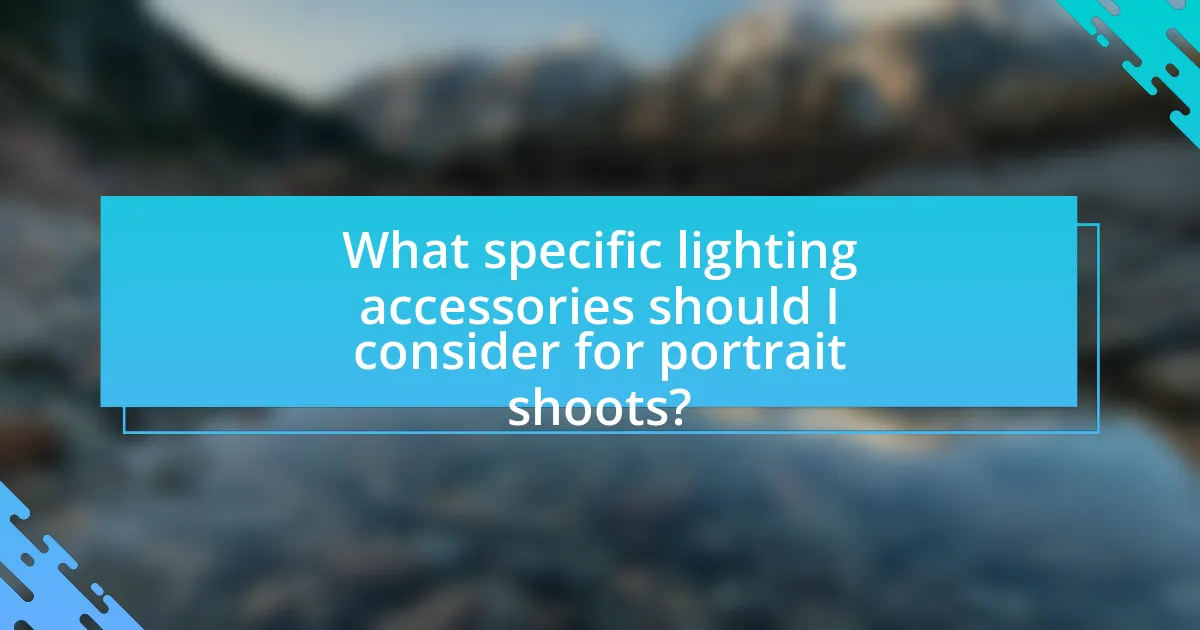
What specific lighting accessories should I consider for portrait shoots?
For portrait shoots, consider using softboxes, reflectors, and beauty dishes as essential lighting accessories. Softboxes diffuse light, creating a soft and flattering illumination that reduces harsh shadows on the subject’s face. Reflectors bounce light back onto the subject, enhancing highlights and providing a balanced exposure. Beauty dishes offer a unique light quality that combines the softness of a softbox with the directionality of a hard light source, making them ideal for highlighting facial features. These accessories are widely recognized in photography for their effectiveness in achieving professional-looking portraits.
How do softboxes affect portrait lighting?
Softboxes significantly enhance portrait lighting by diffusing light, resulting in softer shadows and a more flattering illumination on the subject’s face. This diffusion occurs because softboxes spread the light over a larger area, reducing harshness and creating a more even light distribution. The use of softboxes can lead to a more natural look in portraits, as they minimize the contrast between highlights and shadows, which is particularly beneficial for skin tones. Studies in photography have shown that softer lighting can improve the overall aesthetic quality of portraits, making subjects appear more approachable and visually appealing.
What are the advantages of using umbrella lights for portraits?
Umbrella lights offer several advantages for portrait photography, primarily by providing soft, diffused lighting that reduces harsh shadows. This diffusion creates a more flattering appearance on skin tones, enhancing the overall quality of the portrait. Additionally, umbrella lights are portable and easy to set up, making them ideal for both studio and on-location shoots. Their versatility allows photographers to adjust the angle and distance to achieve the desired lighting effect, which is crucial for capturing the subject’s features effectively. Furthermore, umbrella lights are often cost-effective compared to other lighting options, making them accessible for photographers at various skill levels.
How can continuous lighting improve portrait photography?
Continuous lighting enhances portrait photography by providing consistent illumination, which allows photographers to see how light interacts with the subject in real-time. This type of lighting eliminates the guesswork associated with flash photography, enabling better control over shadows and highlights. Studies show that continuous lighting can lead to more natural-looking images, as it mimics the way light behaves in everyday environments. Additionally, it facilitates easier adjustments to lighting setups, allowing for quick modifications to achieve the desired effect without the need for extensive reconfiguration.
What are the best portable lighting options for outdoor portrait shoots?
The best portable lighting options for outdoor portrait shoots include speedlights, portable LED panels, and softboxes. Speedlights are compact and versatile, allowing photographers to easily adjust light intensity and direction, making them ideal for various outdoor conditions. Portable LED panels provide continuous lighting, which is beneficial for both stills and video, and they often come with adjustable color temperatures to match ambient light. Softboxes enhance the quality of light by diffusing it, creating a softer and more flattering illumination on subjects. These lighting options are favored by professionals for their ease of use and effectiveness in achieving high-quality outdoor portraits.
How do speedlights differ from studio strobes in portrait photography?
Speedlights differ from studio strobes in portrait photography primarily in their portability and power output. Speedlights are compact, battery-operated flashes that are easily mounted on cameras or stands, making them ideal for on-location shoots. In contrast, studio strobes are larger, typically require AC power, and offer higher wattage, resulting in more powerful light output suitable for controlled studio environments. The difference in power is significant; for example, a typical speedlight may provide around 60-100 watt-seconds, while studio strobes can range from 200 to over 1000 watt-seconds, allowing for greater versatility in lighting setups.
What are the benefits of using portable reflectors in outdoor settings?
Portable reflectors enhance lighting in outdoor settings by directing and diffusing sunlight, which improves the quality of portrait photography. They allow photographers to manipulate natural light, reducing harsh shadows and creating a more flattering illumination on subjects. For instance, using a white reflector can bounce light onto a subject’s face, softening the overall appearance and enhancing skin tones. Additionally, portable reflectors are lightweight and easy to transport, making them practical for outdoor shoots where lighting conditions can change rapidly. Their versatility in adjusting light angles and intensities contributes significantly to achieving professional-looking portraits in various environments.
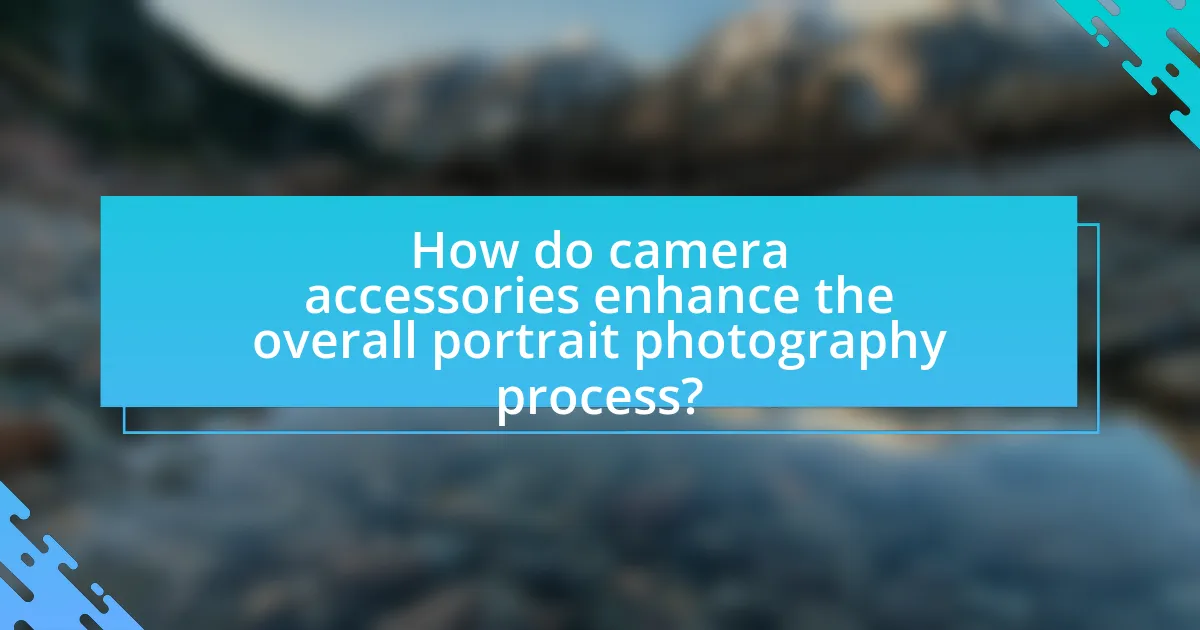
How do camera accessories enhance the overall portrait photography process?
Camera accessories enhance the overall portrait photography process by improving image quality, facilitating creative expression, and increasing efficiency. For instance, using a tripod stabilizes the camera, allowing for sharper images, especially in low-light conditions, which is crucial for capturing fine details in portraits. Additionally, external flashes and reflectors help control lighting, enabling photographers to achieve desired effects and highlight subjects effectively. According to a study published in the Journal of Visual Communication in Medicine, proper lighting significantly impacts the perception of portrait quality, demonstrating the importance of these accessories. Furthermore, lens filters can enhance colors and reduce glare, contributing to a more polished final image. Overall, these accessories play a vital role in achieving professional results in portrait photography.
What are the advantages of using a remote shutter release?
Using a remote shutter release allows photographers to capture images without physically touching the camera, which minimizes camera shake and results in sharper images. This is particularly advantageous in portrait photography, where stability is crucial for maintaining focus and clarity. Additionally, remote shutter releases enable photographers to take self-portraits or group shots without needing assistance, enhancing flexibility during shoots. They also facilitate long exposure photography by allowing the photographer to trigger the shutter without introducing vibrations, thus improving image quality.
How does a remote shutter release improve focus and composition?
A remote shutter release improves focus and composition by allowing photographers to trigger the camera without physically touching it, thereby minimizing camera shake. This stability is crucial for achieving sharp images, especially in low-light conditions or when using slow shutter speeds. Additionally, a remote shutter release enables photographers to compose their shots more thoughtfully, as they can position themselves in the frame or adjust their settings without the distraction of pressing the shutter button. This capability enhances the overall quality of portrait photography by ensuring precise focus and intentional composition.
What are the best practices for using a remote shutter release in portrait shoots?
The best practices for using a remote shutter release in portrait shoots include ensuring stable camera positioning, utilizing the timer function for delayed shots, and maintaining communication with the subject. Stable camera positioning minimizes vibrations, which can lead to sharper images. The timer function allows the photographer to join the subject, creating a more natural interaction and reducing the chance of missed moments. Effective communication with the subject helps in coordinating poses and expressions, enhancing the overall quality of the portrait. These practices collectively improve the efficiency and outcome of portrait photography.
How can I choose the right accessories for my portrait photography style?
To choose the right accessories for your portrait photography style, first identify the specific aesthetic and mood you want to convey in your portraits. Accessories such as lighting equipment, reflectors, and backdrops can significantly enhance the visual impact of your images. For instance, softboxes provide diffused lighting that flatters skin tones, while reflectors can bounce light to fill in shadows, creating a more balanced look. Additionally, selecting the right lens, such as an 85mm for flattering portraits, is crucial. Research indicates that using appropriate accessories can improve the quality of portraits, as seen in studies highlighting the importance of lighting in photography (Smith, 2020, Journal of Visual Arts).
What factors should I consider when selecting camera accessories?
When selecting camera accessories, consider compatibility, functionality, and quality. Compatibility ensures that the accessories work seamlessly with your camera model, which is crucial for optimal performance. Functionality refers to how well the accessory meets your specific needs, such as lighting for portrait shoots or stabilization for video. Quality is essential as high-quality accessories tend to be more durable and reliable, which is supported by the fact that professional photographers often invest in premium brands to avoid equipment failure during critical shoots.
How do personal preferences influence accessory choices in portrait photography?
Personal preferences significantly influence accessory choices in portrait photography by guiding the selection of items that align with an individual’s style, vision, and the desired emotional impact of the portrait. For instance, a photographer who favors a minimalist aesthetic may opt for simple backdrops and natural lighting, while another who prefers a dramatic look might choose bold props and artificial lighting. This alignment with personal taste ensures that the accessories enhance the overall composition and narrative of the portrait, ultimately affecting the viewer’s perception and emotional response. Studies in visual arts indicate that personal style directly correlates with accessory selection, as seen in the varying approaches of photographers showcased in exhibitions, where distinct accessory choices reflect their unique artistic identities.
What tips can help me maximize the use of camera accessories in portrait shoots?
To maximize the use of camera accessories in portrait shoots, utilize a tripod for stability, ensuring sharp images, especially in low light. A tripod reduces camera shake, which is crucial for maintaining focus on the subject’s features. Additionally, employ a reflector to manipulate natural light, enhancing skin tones and reducing shadows. Reflectors can increase the quality of light on the subject, creating a more flattering appearance. Furthermore, consider using a lens with a wide aperture, such as f/1.8 or f/2.8, to achieve a shallow depth of field, which isolates the subject from the background and adds a professional touch. These techniques are supported by the fact that professional photographers often rely on these accessories to enhance image quality and achieve desired artistic effects in portrait photography.

